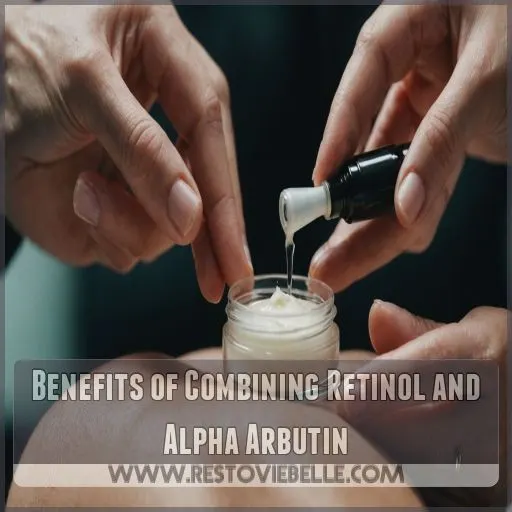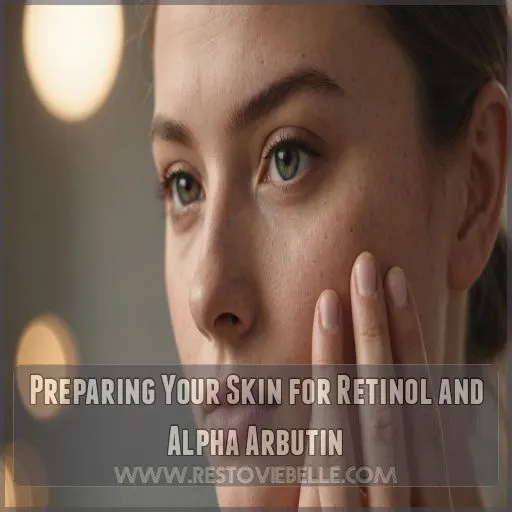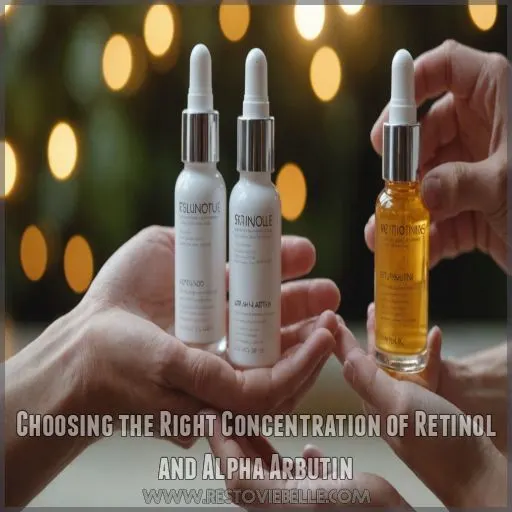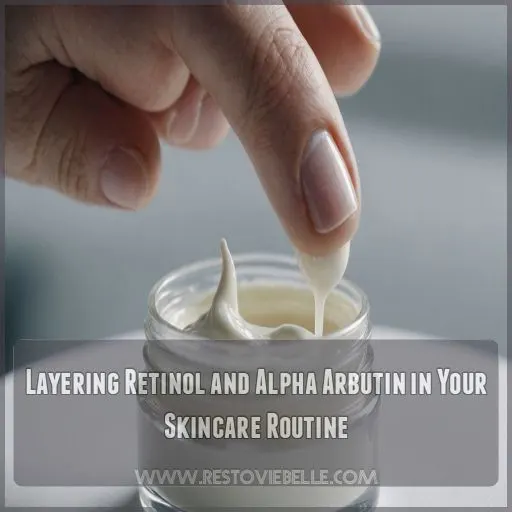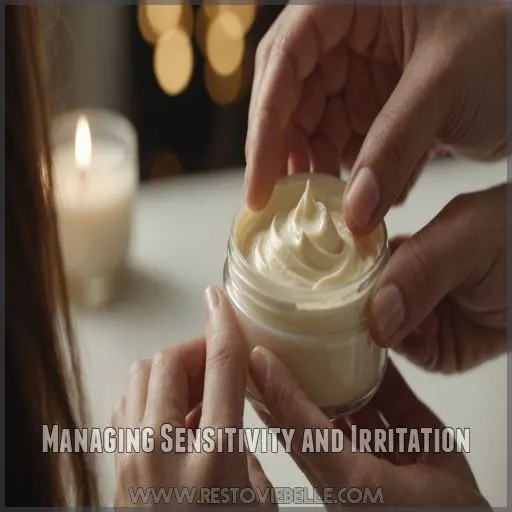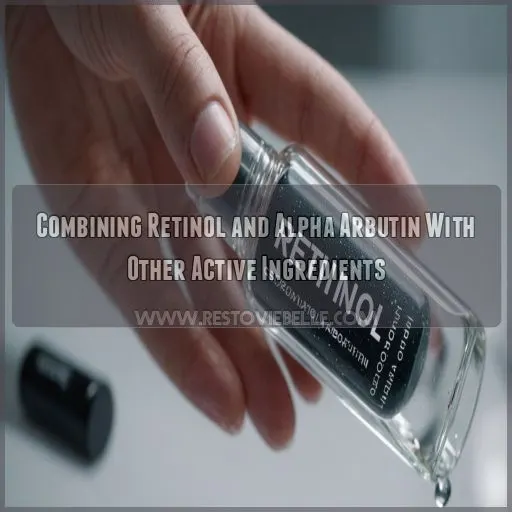This site is supported by our readers. We may earn a commission, at no cost to you, if you purchase through links.
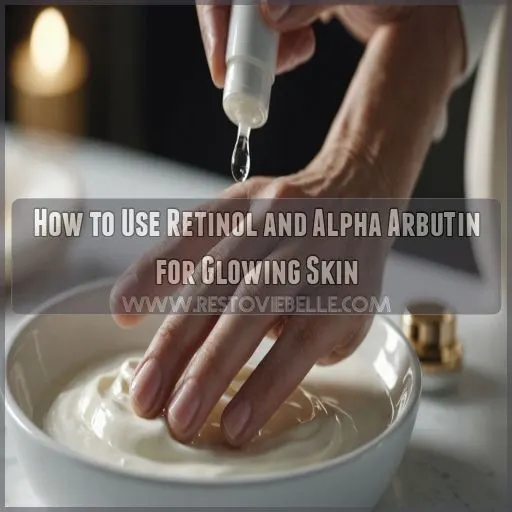
Start by applying alpha arbutin first, then wait 15-20 minutes before slathering on the retinol. It’s like letting your skin digest its appetizer before the main course.
Begin with lower concentrations and use them a few times a week to avoid overwhelming your face. Don’t forget to slap on some sunscreen during the day – your newly radiant skin will thank you. As you build up tolerance, you’ll be on your way to brighter, smoother skin.
But wait, there’s more to this dynamic duo than meets the eye…
Table Of Contents
- Key Takeaways
- Benefits of Combining Retinol and Alpha Arbutin
- Preparing Your Skin for Retinol and Alpha Arbutin
- Choosing the Right Concentration of Retinol and Alpha Arbutin
- Layering Retinol and Alpha Arbutin in Your Skincare Routine
- How Often to Use Retinol and Alpha Arbutin Together
- Potential Interactions and Contraindications
- Managing Sensitivity and Irritation
- Combining Retinol and Alpha Arbutin With Other Active Ingredients
- Frequently Asked Questions (FAQs)
- Can you use alpha arbutin and retinol in the same routine?
- What should I not mix with alpha arbutin?
- What can I layer with alpha arbutin?
- Can I use alpha arbutin every day?
- Can retinol and alpha arbutin be used during pregnancy?
- How long until results are visible?
- Are there age restrictions for using these ingredients?
- Can retinol and alpha arbutin treat melasma effectively?
- Should these ingredients be used on body skin?
- Conclusion
Key Takeaways
- You’re not stuck choosing between retinol and alpha arbutin – these skincare powerhouses can work together like peanut butter and jelly to brighten your complexion and smooth out those pesky fine lines. Just remember to start with lower concentrations and build up slowly, like dipping your toes in the pool before diving in headfirst.
- Layering is key when using retinol and alpha arbutin together. Apply alpha arbutin first, wait 15-20 minutes (maybe do a little dance or practice your skincare routine pep talk), then follow up with retinol. And don’t forget to slather on that SPF during the day – your newly glowing skin will thank you.
- Listen to your skin as if it’s your best friend spilling the tea. If it’s feeling irritated or sensitive, take a step back and reduce frequency or concentration. Patience is a virtue in skincare – Rome wasn’t built in a day, and neither is perfect skin. Consistency is your secret weapon for seeing those radiant results.
- You can play mix and match with other active ingredients, but proceed with caution. Vitamin C in the morning and retinol at night is a match made in skincare heaven. Just avoid mixing retinol with strong acids, or you might end up with a face that feels like it’s been through a chemical peel gone wrong.
Benefits of Combining Retinol and Alpha Arbutin
Combining retinol and alpha arbutin in your skincare routine can work wonders for achieving bright, smooth, and youthful-looking skin.
You’ll love how this dynamic duo tackles fine lines, wrinkles, and uneven skin tone, leaving your complexion looking radiant and refreshed.
Enhanced Skin Brightening
Want clearer skin? Combining retinol and alpha arbutin can make a difference. They work together like peanut butter and jelly, enhancing skin brightening by:
- Reducing melanin for a balanced tone.
- Fading hyperpigmentation and dark spots.
- Creating a consistent brightening routine.
- Supporting sensitive skin with gentle care, like using electric shavers designed for sensitive skin.
Give these products a try for a radiant glow!
Improved Skin Texture and Tone
Combining retinol and alpha arbutin can work wonders for improving your skin’s texture and tone.
These powerhouse ingredients team up to minimize the appearance of uneven pigmentation, revealing a more radiant, luminous complexion.
Expect smoother, more refined skin with a healthy, youthful glow – the perfect canvas for makeup or bare-faced beauty.
Reduced Appearance of Fine Lines and Wrinkles
In the bustling journey of aging skin, retinol and alpha arbutin are like trusty guides, often reducing fine lines and wrinkles.
Their dynamic duo in your skincare routine breathes a touch of youthful charm back into your face.
You’ll find that these anti-aging tips can wave a magic wand, shuffle those worry lines, and let you regain control over time’s tick-tock.
Increased Collagen Production
If you’re looking to boost collagen production, these skincare ingredients are your ace in the hole. Retinol and alpha arbutin team up like a dynamic duo, helping you combat the aging process.
Retinol—a potent form of vitamin A—enhances skin elasticity and aids wrinkle reduction, while alpha arbutin contributes to a youthful glow.
Embrace the journey to better skin health!
Preparing Your Skin for Retinol and Alpha Arbutin
Before you start using retinol and alpha arbutin, it’s really important to prepare your skin by introducing these powerful ingredients gradually.
Just like you wouldn’t enter a marathon without training, give your skin time to adjust.
Sunscreen is your best friend on this journey.
Patch Testing for Sensitivity
Before diving into retinol and alpha arbutin, it’s really important to patch test.
Choose a small, inconspicuous area and apply a pea-sized amount of each product.
Wait 24-48 hours, watching for any redness, irritation, or sensitivity.
This allows you to gauge your skin’s reaction before fully incorporating these potent actives into your routine.
Gradually Introducing Active Ingredients
Diving into a new skincare routine is like starting a relationship—take it slow.
Gradually introduce retinol and alpha arbutin to your skincare lineup to avoid overwhelming your skin.
Imagine your skin as a delicate flower, not wanting too much water at once. Start with a lower frequency to maintain a healthy skin barrier and prevent irritation.
Building Up Skin Tolerance
You’ve patch-tested and dipped a toe in the retinol and alpha arbutin waters.
Now, you’ve got to build up skin tolerance.
Think of it like weightlifting for your face—start slow, flex those skin barrier muscles with gradual introduction.
Sensitive skin types, listen up!
You’re the gentle giants here.
Choose a retinol serum wisely, strengthening with patience and grit.
Importance of Sunscreen Protection
While your skin builds tolerance to retinol and alpha arbutin, don’t underestimate sunscreen’s power.
Think of it as a superhero shield against UV damage.
Trust me, myths about SPF "activation" are just that—myths!
Apply daily, like brushing teeth.
Whether you prefer zinc PCA or benzoyl peroxide formulations, this layer’s got your back.
Protecting skin means saying "yes" to future freedom.
Choosing the Right Concentration of Retinol and Alpha Arbutin
With retinol and alpha arbutin, less is often more.
Start with lower concentrations and gradually increase based on your skin’s tolerance.
This will help minimize irritation and maximize the benefits for your unique complexion.
Starting With Lower Concentrations
Starting with lower concentrations is your skin’s best friend—it eases skin sensitivity while you build tolerance.
Follow this beginner routine:
- Patch Test: Check for reactions behind the ear.
- Gradual Increase: Start slowly—perhaps twice a week.
- Pair Wisely: Use retinol and peptide serum with vitamin C or eye cream.
It’s not rocket science—just gentle steering!
Adjusting Concentrations Based on Skin Type
Beginning with lower concentrations sets the stage; now, tune your products to your skin type.
Got sensitive skin? Go easy with a milder retinol strength and alpha arbutin level.
For tougher skin types feeling up to it, crank it up a notch. Skincare’s no one-size-fits-all!
Always listen to sensitivity factors.
And remember, product recommendations aren’t gospel.
Understanding the Difference Between Retinol and Retinoic Acid
If you’ve ever wondered about retinoid types, here’s the scoop.
Understanding the difference between retinol and retinoic acid is like knowing chocolate cake versus chocolate frosting: same family, different intensity.
Retinol, found in over-the-counter products, is gentle on skin sensitivity.
Retinoic acid packs a punch but needs a prescription.
Application differences matter, so start smart!
Concentration of Alpha Arbutin for Effective Results
For alpha arbutin, the right concentration can make all the difference for your skin.
Opt for a product containing 2-4% alpha arbutin – any higher and you risk irritation.
Your skin type will also guide the perfect alpha arbutin match: normal/combo skin does best with 2%, while dry or sensitive complexions thrive on 3-4%.
Stick with it, and you’ll see a brighter, more even-toned glow in no time!
Layering Retinol and Alpha Arbutin in Your Skincare Routine
Layering retinol and alpha arbutin properly can supercharge your skincare routine, giving you the glow of a thousand selfies without the filters.
Just remember, they’re like peanut butter and jelly—fantastic together when applied correctly, so follow a few tips for the best results.
Order of Application for Optimal Results
Choosing the right concentration sets the stage for successful layering.
Think of your skincare routine as a recipe—order matters!
Use the table below for guidance:
| Step | Product | Purpose | Timing |
|---|---|---|---|
| 1 | Cleanser | Removes impurities | AM/PM |
| 2 | Alpha Arbutin | Brightens and evens skin tone | AM/PM |
| 3 | Retinol | Targets fine lines and wrinkles | PM only |
| 4 | Moisturizer | Hydrates and reinforces barrier | AM/PM |
Combining With Other Active Ingredients
When layering retinol and alpha arbutin, you can also incorporate other active ingredients like vitamin C, niacinamide, and AHAs/BHAs.
Just be mindful of potential irritation – start slow and give your skin time to adjust.
Hyaluronic acid can help boost hydration and minimize dryness.
Listen to your skin and adjust your routine accordingly.
Importance of Moisturizing and Hydrating
Nurturing your skin barrier health is really important when using retinol and alpha arbutin.
Hydration benefits are plenty, so don’t skimp on moisturizers. Keep your face fresh as a daisy with a hydrating routine:
- Lock in moisture with rich creams.
- Opt for gel types if you’re oily-skinned.
- Drink plenty of water.
- Combat dryness with humectants.
Tips for Minimizing Irritation
Maintaining your skin’s health is like tending a garden; it needs patience and care.
Start with a gradual introduction of retinol and alpha arbutin, ensuring product compatibility.
Gentle exfoliation can help but don’t overdo it.
Listen to your skin and adjust as needed to keep irritation at bay.
How Often to Use Retinol and Alpha Arbutin Together
Finding the right frequency for using retinol and alpha arbutin is like learning to dance; start slow and increase the tempo as your skin becomes more confident.
Listen to your skin’s rhythm, adjusting as needed while maintaining consistency for glowing results.
Starting With a Low Frequency
Start low and slow when combining retinol and alpha arbutin.
Your skin needs time to build up tolerance, so begin with just 1-2 times per week.
Gradually work your way up as your complexion acclimates, keeping a close eye for any redness or irritation.
Patience is key – it can take 4-8 weeks to see the full brightening and smoothing benefits.
Gradually Increasing Frequency
You’re off to a great start with a low frequency, but let’s inch forward. Patience is key in building your skin’s tolerance!
Gradually increase usage with these tips:
- Use retinol and alpha arbutin 2-3 times a week.
- Monitor your skin’s response.
- If all goes well, boost to every other night.
Consistency is the name of the game!
Listening to Your Skin and Adjusting
Every face tells its own story, so get to know yours by monitoring reactions when introducing retinol and alpha arbutin into your skincare routine.
Notice changes in sensitivity levels, like redness or dryness, and adjust accordingly.
Sometimes, your skin’s like Goldilocks, needing not too much or too little—just right.
Let your skin’s feedback guide frequency changes for healthier tolerance building.
Importance of Consistency
Consistency is key for achieving long-term results in your skincare journey.
Building tolerance and a consistent routine with retinol and alpha arbutin is like planting seeds for glowing skin—you can’t rush a masterpiece!
Embrace patience, monitor skin progress, and trust the process.
Like brewing a perfect cup of tea, good things take time.
Potential Interactions and Contraindications
When using retinol and alpha arbutin together, it’s important to be mindful of potential interactions and contraindications.
Certain active ingredients may not play nicely, so always patch test and consult your dermatologist, especially if you have sensitive skin or are pregnant or breastfeeding.
With a little care and attention, you can enjoy the skin-transforming benefits of these powerhouse ingredients.
Interactions With Other Active Ingredients
So you’ve found your rhythm with retinol and alpha arbutin.
What about other actives, like Vitamin C or AHAs?
Mixing can be like juggling chainsaws—things might get hairy!
Niacinamide loves everyone, but AHA/BHA with retinol can shake up your skin barrier.
Test the waters first, ensuring product compatibility for that radiant glow!
Contraindications for Sensitive Skin
Sensitive skin’s like a moody cat—it protests unpredictably! If you’re walking this tightrope, tread carefully.
- Patch Testing: Your skin barrier will thank you.
- Product Selection: Choose gentle formulas to avoid flare-ups.
- Frequency: Less is more—don’t overdo it.
Moisturizing is your secret weapon; pamper that skin like a cherished old car!
Precautions for Pregnant or Breastfeeding Women
If you’re pregnant or breastfeeding, you’ll want to steer clear of retinol like it’s the last cookie at a family reunion.
Here’s a handy table to guide you:
| Concern | Recommended Action |
|---|---|
| Retinol Safety | Avoid use |
| Breastfeeding Concerns | Consult a doctor |
| Topical Absorption | Use mild alternatives |
| Expert Advice | Seek professional opinions |
Better safe than sorry, right? Keep glowing safely!
Importance of Patch Testing
Before diving into retinol and alpha arbutin, patch testing is really important.
Always do a small skin test first – apply a pea-sized amount on your inner arm or behind your ear for 24-48 hours.
Watch for any redness, itching, or irritation.
If your skin reacts, these ingredients may not be suitable.
Patch testing helps prevent unwanted flare-ups.
Managing Sensitivity and Irritation
When using retinol and alpha arbutin, it’s not unusual for your skin to throw a bit of a tantrum, showing signs of sensitivity and irritation.
But fear not, with a little hydration and smart strategies, you’ll calm your skin down faster than a toddler with a cookie.
Signs of Sensitivity and Irritation
Spotting skin sensitivity’s like finding a needle in a haystack—annoying yet important.
Look out for redness, burning, dryness, or itching.
Sometimes it’s akin to waking up after a sunburn.
Other times, breakouts scream, "Get this off my face!"
Here’s a quick table to decode those pesky signs:
| Sign | Description |
|---|---|
| Redness | Persistent flush |
| Burning | Tingling warmth |
| Dryness | Parched feeling |
| Itching | Uncontrollable urge |
| Breakouts | Unwanted guests |
Strategies for Minimizing Irritation
Feeling the burn? Listen to your skin and take charge! Combat irritation by:
- Patch testing new products first.
- Maintaining strong skin barrier health.
- Using hydration methods like soothing mists.
- Practicing gentle exfoliation to avoid over-sensitivity.
- Monitoring your product frequency carefully.
Ultimately, your skin’s whispering secret? Balance and patience! Rome wasn’t built in a day, and neither is radiant skin.
Importance of Hydrating and Moisturizing
When your skin feels tight, dry, or irritated from retinol and alpha arbutin, hydration and moisturization are key.
Reach for nourishing, ceramide-rich creams and serums to replenish your skin’s moisture levels.
Hyaluronic acid and glycerin are hydrating superstars that’ll quench thirsty skin, like the hydration hero hyaluronic acid.
Don’t skimp on the moisturizer – it’s your skin’s best friend during active ingredient use.
Tips for Soothing Irritated Skin
To calm irritated skin, reach for gentle products with calming ingredients like chamomile or aloe.
Consider applying cooling masks with soothing properties—they’re a big hug for your face.
Don’t forget hydration tips: opt for lightweight moisturizers that help repair the skin barrier, especially if you’re using products with ingredients like retinol.
You’re the boss of your skincare routine; make adjustments until your skin sings with joy.
Combining Retinol and Alpha Arbutin With Other Active Ingredients
You’ve decided to start a skincare routine, combining retinol and alpha arbutin with other active ingredients.
Don’t worry, it isn’t as hard as learning to parallel park, and soon your skin will thank you with a dazzling glow!
Vitamin C and Retinol
In the quest for perfect skin, combining vitamin C serum with retinol can feel like figuring out a skincare puzzle.
First, incorporate these naturally:
- Apply vitamin C in the morning routine.
- Reserve retinol benefits for your evening routine.
- Watch for skin irritation and adjust if needed.
- Always wear sunscreen!
Who knew glowing skin needed this much planning?
Alpha Arbutin and Niacinamide
Combining alpha arbutin and niacinamide is a dynamic duo for radiant skin.
Niacinamide’s ability to regulate melanin production pairs beautifully with alpha arbutin’s brightening prowess, tackling discoloration and uneven tone.
This dynamic duo also strengthens the skin barrier, minimizing irritation when layered with potent retinol.
Seek out serums and moisturizers featuring this winning combination for a luminous, healthy-looking complexion.
Salicylic Acid and Retinol
Balancing salicylic acid and retinol in your skincare routine can deliver radiant skin, but it’s like walking a tightrope to effectively removing blackheads.
Jumping in too fast might lead you into the pit of irritation.
Start with patch testing and low frequency to reap benefits without side effects.
Explore best products that suit your skin, and soon, you’ll master the art of glowing radiance.
Tips for Layering Multiple Active Ingredients
When you’re layering multiple active ingredients, think of your skincare routine as a delicate dance.
To master this choreography, follow these steps:
- Cleanse thoroughly
- Apply water-based products first
- Layer oil-based products next
- Finish with occlusive creams
Frequently Asked Questions (FAQs)
Can you use alpha arbutin and retinol in the same routine?
Ah, the skincare tango! You can use retinol and alpha arbutin together, but it’s like juggling fire—exciting yet risky.
Start slow, apply them on alternate nights, and always protect your skin with SPF during the day.
What should I not mix with alpha arbutin?
You’re in luck! Alpha arbutin plays well with most ingredients.
Just steer clear of high-pH products like certain toners or cleansers.
They’ll reduce its effectiveness.
Stick to a balanced routine, and you’re golden!
What can I layer with alpha arbutin?
Mixing skincare ingredients is like conducting a symphony.
You can layer alpha arbutin with vitamin C, niacinamide, and hyaluronic acid for a harmonious routine.
It’s also compatible with most moisturizers and sunscreens.
Just avoid strong acids and retinoids.
Can I use alpha arbutin every day?
Yes, you can use alpha arbutin daily.
It’s gentle enough for most skin types and doesn’t increase sun sensitivity.
For best results, apply it consistently and don’t forget your SPF 30+ sunscreen to protect your skin.
Can retinol and alpha arbutin be used during pregnancy?
Figuring out skincare during pregnancy? It’s best to steer clear of retinol and alpha arbutin.
These powerful ingredients might be too risky for your little one.
Consult your doctor for safe alternatives that’ll keep your skin glowing.
How long until results are visible?
You’ll typically see initial improvements within 4-6 weeks, but don’t get discouraged if it takes longer.
Everyone’s skin is unique!
For best results, stick to your routine consistently and give it time to work its magic.
Are there age restrictions for using these ingredients?
While there’s no strict age limit, it’s wise to start using retinol and alpha arbutin in your 20s or 30s.
Don’t wait for wrinkles to appear!
These powerhouse ingredients can benefit most adults, but consult a dermatologist for personalized advice.
Can retinol and alpha arbutin treat melasma effectively?
Retinol and alpha arbutin can be powerful allies in treating melasma.
They work together to fade dark spots and even out skin tone, just like the ingredients in the Evagloss Dark Spot Corrector Serum.
Should these ingredients be used on body skin?
Body skin can benefit from retinol and alpha arbutin too!
Just like your face, these ingredients can tackle aging signs and pigmentation.
Start with lower concentrations and patch test first.
Don’t forget sunscreen – it’s your skin’s best friend!
Conclusion
Like a dynamic duo in a skincare superhero movie, retinol and alpha arbutin can transform your complexion when used together.
By following the tips in this guide on how to use retinol and alpha arbutin together, you’ll be well on your way to achieving that coveted glow.
Remember to start slow, be patient, and listen to your skin.
With consistency and care, you’ll tap into the full potential of these powerhouse ingredients.
So go ahead, embrace the journey to radiant skin – your future self will thank you!

